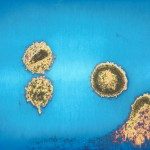Lien vers Pubmed [PMID] – 32376772
Lien DOI – eaay935510.1126/scitranslmed.aay9355
Sci Transl Med 2020 05; 12(542):
Allogeneic hematopoietic stem cell transplantation (allo-HSCT) is the only medical intervention that has led to an HIV cure. Whereas the HIV reservoir sharply decreases after allo-HSCT, the dynamics of the T cell reconstitution has not been comprehensively described. We analyzed the activation and differentiation of CD4+ and CD8+ T cells, and the breadth and quality of HIV- and CMV-specific CD8+ T cell responses in 16 patients with HIV who underwent allo-HSCT (including five individuals who received cells from CCR5Δ32/Δ32 donors) to treat their underlying hematological malignancy and who remained on antiretroviral therapy (ART). We found that reconstitution of the T cell compartment after allo-HSCT was slow and heterogeneous with an initial expansion of activated CD4+ T cells that preceded the expansion of CD8+ T cells. Although HIV-specific CD8+ T cells disappeared immediately after allo-HSCT, weak HIV-specific CD8+ T cell responses were detectable several weeks after transplant and could still be detected at the time of full T cell chimerism, indicating that de novo priming, and hence antigen exposure, occurred during the time of T cell expansion. These HIV-specific T cells had limited functionality compared with CMV-specific CD8+ T cells and persisted years after allo-HSCT. In conclusion, immune reconstitution was slow, heterogeneous, and incomplete and coincided with de novo detection of weak HIV-specific T cell responses. The initial short phase of high T cell activation, in which HIV antigens were present, may constitute a window of vulnerability for the reseeding of viral reservoirs, emphasizing the importance of maintaining ART directly after allo-HSCT.






